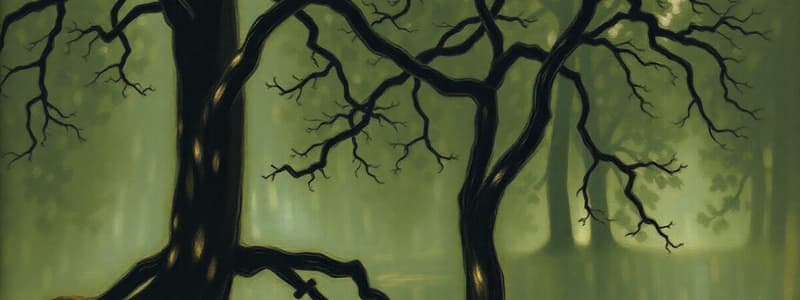Podcast
Questions and Answers
What is a key distinguishing factor between memoirs and autobiographies?
What is a key distinguishing factor between memoirs and autobiographies?
- Autobiographies involve imaginary storytelling.
- Memoirs cover the entirety of a person's life.
- Memoirs focus on a specific event or shorter period. (correct)
- Memoirs are fictional narratives.
Which of the following best describes narrative journalism?
Which of the following best describes narrative journalism?
- A mixture of fiction and traditional reporting.
- Nonfiction writing that emphasizes storycraft and literary techniques. (correct)
- Storytelling that uses primary research without literary techniques.
- An approach that only covers historical events.
What defines the angle in narrative journalism?
What defines the angle in narrative journalism?
- The unique topic being discussed.
- The author's educational background.
- The geographical setting of the narrative.
- The author's perspective on the story subject. (correct)
Which subgenre of creative nonfiction would likely include personal observations and experiences?
Which subgenre of creative nonfiction would likely include personal observations and experiences?
What is the primary purpose of a personal essay?
What is the primary purpose of a personal essay?
In narrative journalism, what is secondary research?
In narrative journalism, what is secondary research?
Which component is NOT considered part of the five elements of fiction important in narrative journalism?
Which component is NOT considered part of the five elements of fiction important in narrative journalism?
What is the role of scope in narrative journalism?
What is the role of scope in narrative journalism?
What is the primary requirement for the facts used in creative nonfiction?
What is the primary requirement for the facts used in creative nonfiction?
Which element is essential for developing the setting in creative nonfiction?
Which element is essential for developing the setting in creative nonfiction?
What role does dialogue play in creative nonfiction?
What role does dialogue play in creative nonfiction?
In creative nonfiction, what is a common method for presenting the narrative?
In creative nonfiction, what is a common method for presenting the narrative?
How does the point of view affect creative nonfiction writing?
How does the point of view affect creative nonfiction writing?
What is the importance of theme in creative nonfiction?
What is the importance of theme in creative nonfiction?
What type of language enhances the creativity of nonfiction writing?
What type of language enhances the creativity of nonfiction writing?
Which of the following is NOT a requirement for characters in creative nonfiction?
Which of the following is NOT a requirement for characters in creative nonfiction?
What distinguishes creative nonfiction from traditional nonfiction?
What distinguishes creative nonfiction from traditional nonfiction?
Which of the following techniques is NOT commonly used in creative nonfiction?
Which of the following techniques is NOT commonly used in creative nonfiction?
What is the primary goal of a creative nonfiction writer when presenting facts?
What is the primary goal of a creative nonfiction writer when presenting facts?
Which of these elements is commonly found in both literary fiction and creative nonfiction?
Which of these elements is commonly found in both literary fiction and creative nonfiction?
How is creative nonfiction's approach to telling stories characterized?
How is creative nonfiction's approach to telling stories characterized?
What role does personal experience play in creative nonfiction?
What role does personal experience play in creative nonfiction?
In which scenarios might a writer choose to use creative nonfiction techniques?
In which scenarios might a writer choose to use creative nonfiction techniques?
What does 100% factual accuracy imply in creative nonfiction?
What does 100% factual accuracy imply in creative nonfiction?
Flashcards are hidden until you start studying
Study Notes
Creative Nonfiction
- Creative nonfiction is factual storytelling that uses creative writing techniques found in poetry and fiction.
- It tells true stories using literary elements like character development, narrative arcs, and poetic elements like conceit and juxtaposition.
- It is a broad genre that encompasses many subgenres, such as memoir, personal essay, narrative journalism, and more.
Elements of Creative Nonfiction
- Must be rooted in facts and thoroughly researched using both primary and secondary sources.
- Requires reporting to accurately document events or personal experiences.
- May include personal experiences or opinions to create a more complete picture.
- Should provide exposition or explanations of the topic or experience.
- Is told like a story, with inciting incidents, goals, challenges, turning points, and resolutions.
- Features characters, often including the narrator as the protagonist in a memoir.
- Requires setting/scene development with vivid descriptions and scenes filled with action and dialogue.
- Emphasizes plot structure with key events that make up the story.
- Uses figurative language, such as similes or metaphors, to create an interesting work.
- Utilizes imagery to bring important scenes alive for the readers.
- Employs point of view, most often in the first person to narrate firsthand experiences.
- Incorporates dialogue to help build the narrative and develop scenes.
- Contains a theme or central idea that ties the whole work together.
Subgenres of Creative Nonfiction
- Memoir: Tells about significant moments in the author's life.
- Personal Essay: Can be written on any subject, but should be personal and connect with the reader on an emotional level.
- Narrative Journalism: Blends storytelling and research. It focuses on the craft of the story, using literary techniques more often found in fiction writing.
Narrative Journalism Explained
- Primary research: Collected firsthand through interviews, surveys, experiments, personal observations, etc.
- Secondary research: Collected by others and accessed through libraries, databases, archives, etc.
- Angle: The author's perspective on the story subject.
- Scope: The narrative coverage (scene/dialogue/etc.) included in the article.
Studying That Suits You
Use AI to generate personalized quizzes and flashcards to suit your learning preferences.




